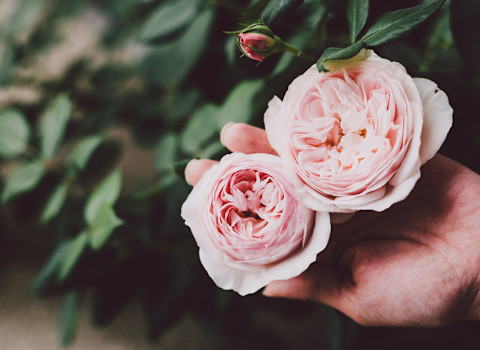
Most of the roses used to make rose otto essential oil are grown in Southern Bulgaria, whereas most of those used for rose absolute are from Morocco, east of Marrakech. What’s the difference? Rose otto essential oil, or attar of rose, is steam-distilled from the petals of the rose, and requires WAY more plant material to produce. Rose absolute is made using solvents like hexane and alcohol to extract the scent molecules—it smells divine and is wonderful in perfumery, but aromatherapists prefer rose otto, as it is produced by a more natural method of extraction. The first rose essential oil was allegedly distilled by a famous Persian polymath, Avicenna, in the 10th century. Until then, the oil had only been extracted by a technique called enfleurage, a beautifully romantic word for a not-so-romantic process of mashing the rose petals in hot fat.

Aromatherapeutic uses.
Rose is used to help treat dysmenorrhea in women (painful menstruation), as well as infertility in women and men. It's an aphrodisiac—a drop on the collar bones can stimulate sensuality in the wearer and anyone in sniffing range. Rose has long been used to treat conditions such as anxiety, insomnia, and grief—it is especially useful in helping people move through states of trauma, allowing them to open to and finally release from sadness.
Perfumery.
Rose absolute, though obtained using solvents rather than steam, captures the true scent of a rose, and is one of the natural perfumer’s most cherished oils. It is soft and lovely, and can unify a blend like no other oil. softening sharp corners in a perfume without taking over the entire aroma—very few oils can do this in natural perfumery. That said, rose is absolutely divine worn alone in a base of jojoba oil, and complicated enough to stand on its own.
Skincare.
Rose otto essential oil is used to decrease redness in skin conditions like rosacea and dermatitis—it has a tonic, astringent effect on the capillaries, making them less visible. It is also excellent for dry, mature, and sensitive skin, and has potent antibacterial activity.
Rose 101.
It takes 10,000 pounds of rose blossoms to make a pound of oil. Still not picturing it? It would take 30 roses to get one, single drop of essential oil. Can you imagine the number of picking hands required to gather 60,000 roses? Now you know why it’s so expensive, and why we are willing to pay $500 per ounce for the certified organic essential oil here at Osmia Organics.
Random rose snippets.
- Fossil evidence suggests that the rose is 35 million years old.
- Rose essential oil contains over 300 known chemical constituents, which make up about 86% of the oil. The other 14% comprises miniscule quantities of unidentified compounds, which is why it’s literally impossible for a synthetic rose fragrance to capture the complicated beauty of the real thing.
- Rose blossoms are harvested by hand just before dawn, because the essential oil yield is highest before the sun has opened and warmed the flowers.
